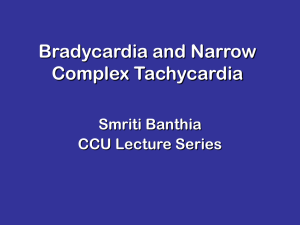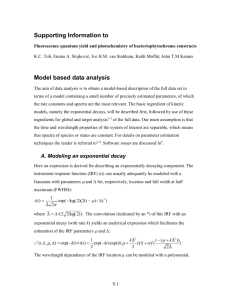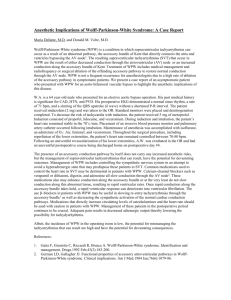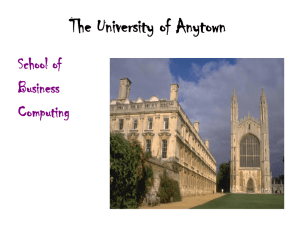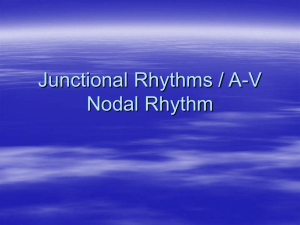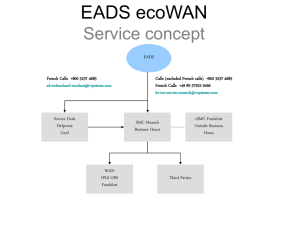Mechanism of Arrhythmia
advertisement
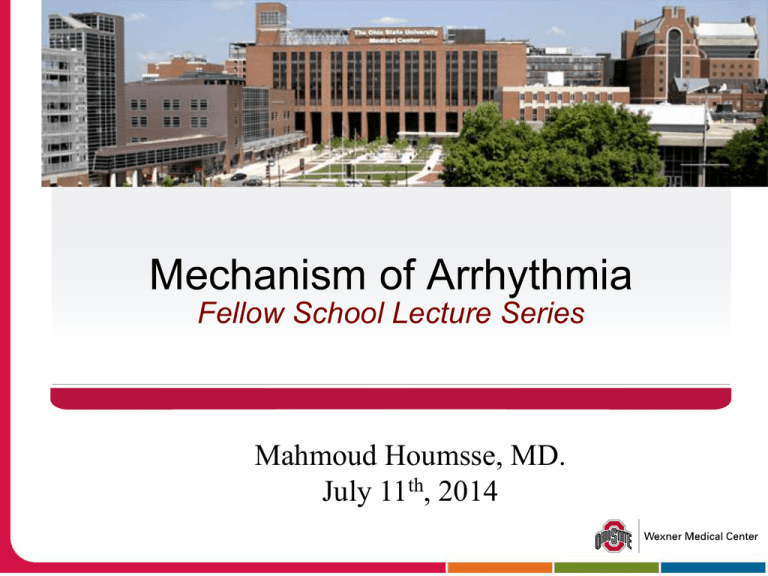
Mechanism of Arrhythmia Fellow School Lecture Series Mahmoud Houmsse, MD. July 11th, 2014 Cardiac Action Potential +30 mV 0 mV -90 mV Transmembrane Potential Basic Catheter Positions Protocol for RFA: 1. Catheters introduced via the femoral vein 2. Try to induce arrhythmia by pacing – defined protocol 3. Confirm diagnosis of type of arrhythmia 4. Map and RFA 5. Retest to assess if RFA was successful His and Right Bundle Potentials Surface ECG I Surface ECG III Right Atrium His Bundle – Junction betwn. RA and RV Right Ventricle Mechanisms Disorder of Impulse Formation ◦ Automaticity ◦ Triggered activity Two major causes of Impulse initiation (used to indicate an electrical impulse that can arise in a single cell or closely coupled cells through depolarization of the cell membrane and rest of myocardium) Each has own unique cellular mechanism Disorders of Impulse Conduction ◦ Reentry 65 y/o Female Presented with Severe Near Syncope and Palpitations Fast, Regular and Narrow: PSVT Mechanisms of Arrhythmias Reentry Dog chasing his tail or a Race Track Scar – tissue that does not conduct AV Node Re-Entrant Tachycardia 1 AV node pathway conducts rapidly Known as the “fast pathway” takes a long time to recover to conduct again 2nd AV node pathway conducts slowly Known as the “slow pathway” takes a short time to conduct another beat AV Node Re-Entrant Tachycardia Typically, PAC blocks in the “fast” pathway, conducts down the “slow” pathway, then back up the “fast” pathway Fast pathway Slow pathway Compact AV node Timed PAC to initiate AVNRT 12 13 Retrograde P wave Atrio-Ventricular Preexcitation WPW Accessory pathway that conducts from atrium to ventricle (and usually from V to A too) Simultaneous conduction creates fusion beat with a delta wave delta wave Atrio-Ventricular Preexcitation WPW Atrio-Ventricular Preexcitation WPW May proceed up or down the accessory pathway Down = antidromic wide complex not common antidromic Atrio-Ventricular Preexcitation WPW May proceed up or down the accessory pathway orthodromic Up = orthodromic narrow complex common Atrio-Ventricular Re-Entry due to a Concealed Bypass Tract Atrium and ventricle are needed to sustain the tachycardia Lack of antegrade conduction “conceals” the presence of this pathway on the ECG There is NO delta wave X Atrio-Ventricular Re-Entry Concealed Accessory Pathway Up the accessory pathway, Down the AV node orthodromic Atrial Tachycardia Automatic Atrial Tachycardia Intra-Atrial Re-Entrant Tachycardia Triggered Automaticity Digitalis Toxicity PSVT Types Atrial Tachycardia AVNRT AVRT/WPW Atrial Flutter Circuit Reentrant Circuit Around Anatomical Barriers Isthmus Slow Conduction Slow Conduction between tricuspid valve & inferior vena cava 52 y/o M with H/O HTN and Recurrent Palpitations Atrial Flutter: Catheter Lying Along Tricuspid Valve Tri. Valve Inf Vena Cava Typical AFL: Intracardiac ECG Recording catheter along tricuspid valve Reentrant VT *The QRS of the VT begins here * Catheter Ablation Procedure: 1. Induce the VT 2. Map the VT circuit, ie, find the zone of slow conduction squeezed by scar 3. Deliver RF energy to destroy the zone of slow conduction and thus eliminate reentry and VT s c a r s c a r “Squeezed by Scar” Step #1 of a VT Ablation Procedure EP Study: Induce VT V1 aVF RA * RV * * * * * VT Early Electrical Signal Recorded at Zone of Slow Conduction………Squeezed by Scar *The QRS of the VT begins here * * s c a r s c a r Successful Ablation Site * * * QRS from Pacing During VT = QRS of the VT *QRS of the VT begins here * * * * * * ** * * s c a r * s c a r Pace here Concealed entrainment * * * * * * ** * Spontaneous impulse initiation is a process whereby cardiac cells undergo spontaneous diastolic depolarization (phase 4) and initiate electrical impulse in the absence of external stimulation. Enhanced Normal Automaticity – refers to accelerated generation of Action Potential (AP) by normal pacemaker tissue Abnormal Automaticity occurs in cardiac cells when there are major abnormalities in transmembrane potentials Drugs, (digoxin) Cardiac disease, CAD, Electrolytes Change in autonomic nervous Normal Cardiac Automaticity Automaticity Normal Automatcity-Intrinsic Rate determined by Diastolic potential Threshold potential Slope of phase 4 Change in any above will alter rate of impulse formation Above factors influenced by sympathetic / parasympathetic systems Automaticity Parasympathetic Reduces spontaneous discharge of SN Sympathetic Increase slope of diastolic depolarization Enhances pacemaker activity Tissues with Intrinsic Automaticity SA node 60 to 100 bpm AV node 40 to 60 bpm Ventricular specialized conduction tissue 20-30 bpm Automatcity & Overdrive Suppression Triggered activity After-depolarizations are depolarizing oscillations in membrane potential that follow the upstroke of a preceding action potential. ◦ Can occur early during repolarization phase of (Early afterdepolarization) or ◦ After completion of repolarization phase (Delayed afterdepolarization) Triggered Activity Triggered activity is not a self-generating rhythm. But occurs as a response to a preceding impulse (the trigger) Automatic rhythms can arrive de novo in the absence of prior electrical activity DADs DADs usually occur when Calcium Overload develops in the Myoplasm and Sarcoplasmic Reticulum Possible Therapeutic meds include CCB and BB DADs During repolarization Calcium influx can rise to critical level and cause secondary spontaneous release of Calcium DADs of Low Amplitude, usually not significant However, during pathological conditions Ischemia, Acidosis, Low Mg, Digitalis toxicity, Rapid Atrial Pacing, Increased Catecholamines Amplitude of oscillations is increased. If process continues, tachycardia will ensue (RVOT) Other causes, geneteic (Ryanodine receptor aka RYR2) Calcium Influx Pathways Earlier DADs with increasing amplitude DAD earlier DAD even earlier DADs Duration of AP Decrease in Cycle Length (sinus tachycardia or paced rhythm) Triggered activity is influenced markedly by overdrive pacing (both rate and duration) Overdrive acceleration obsereved with triggered rhythm Overdrive suppression observed with automatic rhythms EADs Occur at phase 2 and 3 More likely to propagate when membrane potential is more negative. Fundamental condition that underlies the development of EADS is AP prolongation which is manifested by polonged QT. Hypokalemia, Hypomagnesemia, Bradycardia and Drugs predispose to formation of EADs (Antibiotics, Non-sedating Antihistamines) EAD mediated triggered activity likely underlies initiation of characteristic PMVT DADs Vs. EADs DADs are dependent on a rise in intracellular Calcium. EADs are dependent on AP prolongation. Pacing induced increases in heart rate shorten the AP duration and reduce EAD amplitude Initiation of single premature depolarization will reduces the magnitude of EADs Exception is long compensatrory pause followed by PVC. Questions??
